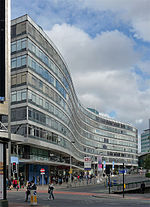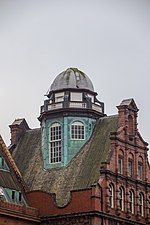Manchester Piccadilly is the principal railway station in Manchester, England. Opened as Store Street in 1842, it was renamed Manchester London Road in 1847 and became Manchester Piccadilly in 1960. Located to the south-east of Manchester city centre, it hosts long-distance intercity and cross-country services to national destinations including London, Birmingham, Nottingham, Glasgow, Edinburgh, Cardiff, Bristol, Exeter, Plymouth, Reading, Southampton and Bournemouth; regional services to destinations in Northern England including Liverpool, Leeds, Sheffield, Newcastle and York; and local commuter services around Greater Manchester. It is one of 19 major stations managed by Network Rail. The station has 14 platforms: 12 terminal and two through platforms (numbers 13 and 14). Piccadilly is also a major interchange with the Metrolink light rail system with two tram platforms in its undercroft.
Piccadilly is the busiest station in the Manchester station group with over 30 million passenger entries and exits between April 2019 and March 2020 (the other major stations in Manchester are Oxford Road and Victoria). As of March 2020, it is the third-busiest station in the United Kingdom outside of London (after Birmingham New Street and Glasgow Central), and is also the fourth-busiest interchange station outside London, with over 2 million passengers changing trains annually. The station hosts services from six train operating companies.
Between the late 1990s and early 2000s, Piccadilly station was refurbished, taking five years and costing £100 million (in 2002); it was the most expensive improvement on the UK rail network at the time. Further improvements and expansion plans have been proposed. In December 2014, a Transport and Works Act application was submitted for the construction of two through platforms as part of the Manchester Piccadilly and Manchester Oxford Road Capacity Scheme. As of 2023, this application has not been approved by the incumbent government although Network Rail declared the Castlefield corridor through Manchester 'congested' in September 2019.A new Manchester Piccadilly High Speed station is planned to be built on a viaduct parallel to the north side of the existing station. The station will have six platforms (three islands) for both terminating High Speed 2 trains from London and Birmingham as well as Northern Powerhouse Rail trains to Liverpool, Warrington, Huddersfield, Leeds and beyond. The present Piccadilly Metrolink stop is proposed to be relocated from ground-level below the existing station platforms to a new larger four-platform stop located underground below the high speed station. Provision for a second ground-level Metrolink stop at the eastern end of the high speed station to service future Metrolink extensions, to be called Piccadilly Central, also form part of the plans. A hybrid bill was laid in Parliament on 24 January 2022 seeking powers to permit construction of the scheme.










